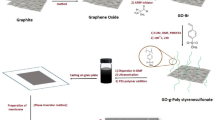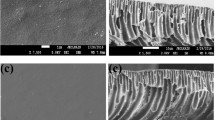Abstract
Ultrafiltration (UF) composite and blend membranes from poly(2,3,4,6-tetra-O-acetyl-D-glucopyranoside methacrylate) (GP)-grafted MCNTs (GP-graft-CNTs) and GP homopolymer with different weight ratios of PSF and PVP were fabricated for antifouling application. Some portions of each fabricated nanocomposite and blend membranes were chemically treated to deacetylate the pendant acetyl glucopyranoside moieties of macromolecular chains to obtain hydrophilic pendant D-glucopyranoside units of macromolecular chain grafts of MCNTs and GP homopolymer in UF membranes. Fouling features of the membranes at 2 bar functioning pressure were evaluated by permeating BSA solutions and oil–water emulsion. The tri-polymer blend UF membranes exhibited 96% BSA rejection (GP3-T membrane) and 93% oil rejection (GP1 membrane) whereas composite membranes showed 89% BSA (g-GPC2) and 83% oil (g-GPC3) rejections from their respective feeds. The deacetylated nanocomposite membrane, g-GPC1-T (GP-graft-CNTs/PSF/PVP at 0.33/86.67/13 weight ratio) exhibited superior flux for BSA solution (135 LMH) than the fabricated membranes (nanocomposite membranes: 88–132 LMH; GP/PSF/PVP = 46–88 LMH) at 2 bar operating pressure. Composite membranes exhibited flux for oil–water feeds even after 8 h whereas the blend membranes showed no flux after 1 h. The modified nanocomposite membrane for oil–water emulsion feeds, g-GPC1 exhibited a maximum 230 LMH flux having oil rejection of 75%. Treated composite membranes demonstrated a higher flux recovery ratio (FRR = 87–94%) than the untreated nanocomposite membranes (FRR = 17–37%) and blend membranes of GP/PSF/PVP (FRR = 51–81% for as-cast membranes and FRR = 13–22% for treated membranes) for oil–water emulsion feeds.










Similar content being viewed by others
References
Montgomery MA, Elimelech M (2007) Water and sanitation in develo** countries: Including health in the equation. Envron Sci Technol 41:17–24. https://doi.org/10.1021/es072435t
Kajitvichyanukul P, Hung YT, Wang LK (2011) Membrane and desalination technologies, Wang LK, Chen JP, Hung YT, Shammas NK (Eds.), Handbook of Environmental Engineering, vol. 13, The Humana Press Inc., New York.
Zeman LJ, Zydney AL (1996) Microfiltration and ultrafiltration: Principles and applications. Marcek Dekker Inc., New York
Rana D, Matsuura T (2010) Surface modifications for antifouling membranes. Chem Rev 110:2448–2471. https://doi.org/10.1021/cr800208y
Sainath AVS, Reddy AVR (2013) Modification of polysulfone with pendant carboxylic acid functionality for ultrafiltration membrane applications. Bull Mater Sci 36:271–276. https://doi.org/10.1007/s12034-013-0447-2
Bradley RS, Vuille M, Diaz HF, Vergara W (2006) Threats to water supplies in the tropical Andes. Science 312:1755–1756. https://doi.org/10.1126/science.1128087
Shannon MA, Bohn PW, Elimelech M, Georgiadis JG, Marinas BJ, Mayes AM (2008) Science and technology for water purification in the coming decades. Nature 452:301–310. https://doi.org/10.1038/nature06599
Pendergast MM, Hoek EM (2011) A review of water treatment membrane nanotechnologies. Energy Environ Sci 4:1946–1971. https://doi.org/10.1039/C0EE00541J
Elimelech M, Phillip WA (2011) The future of seawater desalination: Energy, technology and the environment. Science 333:712–717. https://doi.org/10.1126/science.1200488
Arunkumar A, Etzel MR (2015) Negatively charged tangential flow ultrafiltration membranes for whey protein concentration. J Membr Sci 475:340–348. https://doi.org/10.1016/j.memsci.2014.10.049
Liu TY, Zhang RX, Li Q, Van der Bruggen B, Wang XL (2014) Fabrication of a novel dual-layer (PES/PVDF) hollow fiber ultrafiltration membrane for wastewater treatment. J Membr Sci 472:119–132. https://doi.org/10.1016/j.memsci.2014.08.028
Maruf SH, Greenberg AR, Pellegrino J, Ding Y (2014) Influence of substrate processing and interfacial polymerization conditions on the surface topography and permselective properties of surface-patterned thin-film composite membranes. J Membr Sci 471:65–71. https://doi.org/10.1016/j.memsci.2016.04.003
Feins M, Sirkar KK (2004) Highly selective membranes in protein ultrafiltration. Biotechnol Bioeng 86:603–611. https://doi.org/10.1002/bit.20069
Santosh V, Babu PV, Gopinath J, Rao NNM, Sainath AVS, Reddy AVR (2020) Development of hydroxyl and carboxylic acid functionalized CNTs–polysulphone nanocomposite fouling-resistant ultrafiltration membranes for oil–water separation. Bull Mater Sci 43:125. Bull Mater Sci (2020) 43:125 https://doi.org/10.1007/s12034-020-2079-7
Ganj M, Asadollahi M, Mousavi SA, Bastani D, Aghaeifard F (2019) Surface modification of polysulfone ultrafiltration membranes by free radical graft polymerization of acrylic acid using response surface methodology. J Polym Res 26:231. https://doi.org/10.1007/s10965-019-1832-3
Ge Q, Ding L, Wu T, Xu G, Yang F, **ang M (2017) Effect of Surfactant on morphology and pore size of polysulfone membrane. J Polym Res 25:21. https://doi.org/10.1007/s10965-017-1410-5
Jaleh B, Zare E, Saeid Azizian S, Qanati O, Nasrollahzadeh M, Varma RS (2020) Preparation and characterization of polyvinylpyrrolidone/polysulfone ultrafltration membrane modifed by graphene oxide and titanium dioxide for enhancing hydrophilicity and antifouling properties. J Inorg Organomet Polym Mater 30:2213–2223. https://doi.org/10.1007/s10904-019-01367-x
Zhang DL, Zha JW, Li CQ, Li WK, Li JX (2017) Functionalization of multi-walled carbon nanotubes by radiation-induced graft polymerization in aqueous solution. Fuller Nanotub Car N 25:250–255. https://doi.org/10.1080/1536383X.2017.1283617
Zhang Q, Lei M, Huang S, Fu H, Yan G, Li L, Yan H (2017) Preparation, characterization, and properties of disulfide-containing polyethyleneimine grafted carbon nanotubes. Fuller Nanotub Car N 25:386–390. https://doi.org/10.1080/1536383X.2017.1320546
Kim SW, Kim T, Kim YS, Choi HS, Lim HJ, Yang SJ, Park CR (2012) Surface modifications for the effective dispersion of carbon nanotubes in solvents and polymers. Carbon 50:3–33. https://doi.org/10.1016/j.carbon.2011.08.011
(a) Qu L, Veca LM, Lin Y, Kitaygorodskiy A, Chen B, McCall AM, Sun YP (2005) Soluble nylon-functionalized carbon nanotubes from anionic ring-opening polymerization from nanotube surface. Macromolecules 38:10328–10331. https://doi.org/10.1021/ma051762n. (b) Buffa F, Hu H, Resasco DE (2005) Side-wall functionalization of single-walled carbon nanotubes with 4-hydroxymethylaniline followed by polymerization of caprolactone. Macromolecules 38:8258–8263. https://doi.org/10.1021/ma050876w. (c) Gao J, Itkis ME, Yu A, Bekyarova E, Zhao B, Haddon RC (2005) Continuous spinning of a single-walled carbon nanotube-nylon composite fiber. J Am Chem Soc 127:3847–3854. https://doi.org/10.1021/ja0446193
Kong H, Gao C, Yan D (2004) Constructing amphiphilic polymer brushes on the convex surfaces of multi-walled carbon nanotubes by in situ atom transfer radical polymerization. J Mater Chem 14:1401–1405. https://doi.org/10.1039/B401180E
Zeng HL, Gao C, Yan DY (2006) Poly(ε-caprolactone)-functionalized carbon nanotubes and their biodegradation properties. Adv Funct Mater 16:812–818. https://doi.org/10.1002/adfm.200500607
Gu J, **ao P, Chen J, Zhang J, Huang Y, Chen T (2014) Janus polymer/carbon nanotube hybrid membranes for oil/water separation. ACS Appl Mater Interfaces 6:16204–16209. https://doi.org/10.1021/am504326m
Zhu Y, Wang D, Jiang L, ** J (2014) Recent progress in develo** advanced membranes for emulsified oil/water separation. NPG Asia Mater 6:1–11. https://doi.org/10.1038/am.2014.23
Abed MRM, Kumbharkar SC, Groth AM, Li K (2012) Ultrafiltration PVDF hollow fibre membranes with interconnected bicontinuous structures produced via a single-step phase inversion technique. J Membr Sci 407–408:145–154. https://doi.org/10.1016/j.memsci.2012.03.029
Liu F, Abed MRM, Li K (2011) Preparation and characterization of poly(vinylidene fluoride) (PVDF) based ultrafiltration membranes using nano γ-Al2O3. J Membr Sci 366:97–103. https://doi.org/10.1016/j.memsci.2010.09.04
Huang ZQ, Zheng F, Zhang Z, Xu HT, Zhou KM (2012) The performance of the PVDF-Fe3O4 ultrafiltration membrane and the effect of a parallel magnetic field used during the membrane formation. Desalination 292:64–72. https://doi.org/10.1016/j.desal.2012.02.010
Vatanpour V, Madaeni SS, Moradian R, Zinadini S, Astinchap B (2011) Fabrication and characterization of novel antifouling nanofiltration membrane prepared from oxidized multiwalled carbon nanotube/polyethersulfone nanocomposite. J Membr Sci 375:284–294. https://doi.org/10.1016/j.memsci.2011.03.055
Daramola MO, Hlanyane P, Sadare OO, Oluwasina OO, Iyuke SE (2017) Performance of carbon nanotube/polysulfone (CNT/PSF) composite membranes during oil–water mixture separation: Effect of CNT dispersion method. Membranes 7:14. https://doi.org/10.3390/membranes7010014
Nunes SP, Car A (2013) From charge-mosaic to micelle self-assembly: Block copolymer membranes in the last 40 years. Ind Eng Chem Res 52:993–1003. https://doi.org/10.1021/ie202870y
Santosh V, Gopinath J, Babu VP, Sainath AVS, Reddy AVR (2018) Acetyl-D-glucopyranoside functionalized carbon nanotubes for the development of high performance ultrafiltration membranes. Sep Purif Technol 191:134–143. https://doi.org/10.1016/j.seppur.2017.09.018
Sianipar M, Kim SH, Khoiruddin IF, Wenten IG (2017) Functionalized carbon nanotube (CNT) membrane: Progress and challenges. RSC Adv 7:51175–51198. https://doi.org/10.1039/c7ra08570b
Rana D, Matsuura T, Narbaitz RM, Feng C (2005) Development and characterization of novel hydrophilic surface modifying macromolecule for polymeric membranes. J Membr Sci 249:103–112. https://doi.org/10.1016/j.memsci.2004.09.034
Rana D, Matsuura T, Narbaitz RM (2006) Novel hydrophilic surface modifying macromolecules for polymeric membranes: Polyurethane ends capped by hydroxy group. J Membr Sci 282:205–216. https://doi.org/10.1016/j.memsci.2006.05.024
Kim Y, Rana D, Matsuura T, Chung W-J (2009) Influence of surface modifying macromolecules on the surface properties of poly(ether sulfone) ultra-filtration membranes. J Membr Sci 338:84–91. https://doi.org/10.1016/j.memsci.2009.04.017
Kim Y, Rana D, Matsuura T, Chung W-J, Khulbe KC (2010) Relationship between surface structure and separation performance of poly(ether sulfone) ultra-filtration membranes blended with surface modifying macromolecules. Sep Purif Technol 72:123–132. https://doi.org/10.1016/j.seppur.2010.01.006
Chen Y, Deng Q, **ao J, Nie H, Wu L, Zhou W, Huang B (2007) Controlled grafting from poly(vinylidene fluoride) microfiltration membranes via reverse atom transfer radical polymerization and antifouling properties. Polymer 48:7604–7613. https://doi.org/10.1016/j.polymer.2007.10.043
Du JR, Peldszus S, Huck PM, Feng X (2009) Modification of poly(vinylidene fluoride) ultrafiltration membranes with poly(vinyl alcohol) for fouling control in drinking water treatment. Water Res 43:4559–4568. https://doi.org/10.1016/j.watres.2009.08.008
Yang XX, Deng B, Liu ZY, Shi LQ, Bian XK, Yu M, Li LF, Li JY, Lu XF (2010) Microfiltration membranes prepared from acrylamide grafted poly(vinylidene fluoride) powder and their pH sensitive behaviour. J Membr Sci 362:298–305. https://doi.org/10.1016/j.memsci.2010.06.057
Ren L, Zhang J, Hardy CG, Doxie D, Fleming B, Tang C (2012) Preparation of cobaltocenium-labeled polymers by atom transfer radical polymerization. Macromolecules 45:2267–2275. https://doi.org/10.1021/ma202725c
Kuila BK, Park K, Dai L (2010) Soluble P3HT-grafted carbon nanotubes: Synthesis and photovoltaic application. Macromolecules 43:6699–6705. https://doi.org/10.1021/ma100917p
Trinadh M, Kannan G, Rajasekhar T, Sainath AVS, Dhayal M (2014) Synthesis of glycopolymers at various pendant spacer lengths of glucose moiety and their effects on adhesion, viability and proliferation of osteoblast cells. RSC Adv 4:37400–37410. https://doi.org/10.1039/C4RA05436A
Trinadh M, Govindaraj K, Rajasekhar T, Dhayal M, Sainath AVS (2015) Synthesis and characterization of poly(ethylene oxide)-based glycopolymers and their biocompatibility with osteoblast cells. Polym Int 64:795–803. https://doi.org/10.1002/pi.4854
Kong H, Gao C, Yan D (2004) Controlled functionalization of multiwalled carbon nanotubes by in situ atom sransfer radical polymerization. J Am Chem Soc 126:412–413. https://doi.org/10.1021/ja0380493
Choi JH, Jegal J, Kim WN (2006) Fabrication and characterization of multi-walled carbon nanotubes/polymer blend membranes. J Membr Sci 284:406–415. https://doi.org/10.1016/j.memsci.2006.08.013
Tamura M, Uragami T, Sugihara M (1981) Studies on syntheses and permeabilities of special polymer membranes: 30. Ultrafiltration and dialysis characteristics of cellulose nitrate-poly(vinyl pyrrolidone) polymer blend membranes. Polymer 22:829–835. https://doi.org/10.1016/0032-3861(81)90024-0
Alia NA, Sofiah H, Asmadi A, Endut A (2011) Preparation and characterization of a polysulfone ultrafiltration membrane for bovine serum albumin separation: Effect of polymer concentration. Desalin Water Treat 32:248–255. https://doi.org/10.5004/dwt.2011.2707
Zulkali MMD, Ahmad AL, Derek CJC (2005) Membrane application in proteomic studies: Preliminary studies on the effect of pH, ionic strength and pressure on protein fractionation. Desalination 179:381–390. https://doi.org/10.1016/j.desal.2004.11.084
Kumar S, Nandi BK, Guria C, Mandal A (2017) Oil removal from produced water by ultrafiltration using polysulfone membrane. Braz J Chem Eng 34:583–596. https://doi.org/10.1590/0104-6632.20170342s20150500
Koĺtuniewicz AB, Field RW (1996) Process factors during removal of oil-in-water emulsions with cross-flow microfiltration. Desalination 105:79–89. https://doi.org/10.1016/0011-9164(96)00061-6
Pasparakis G, Alexander C (2008) Sweet talking double hydrophilic block copolymer vesicles. Angew Chem Int Ed 47:4847–4850. https://doi.org/10.1002/anie.200801098
Urkiaga A, Iturbe D, Etxebarria J (2015) Effect of different additives on the fabrication of hydrophilic polysulfone ultrafiltration membranes. Desalin Water Treat 56:3415–3426. https://doi.org/10.1080/19443994.2014.1000976
Kim KJ, Fane AG, Aim RB, Liu MG, Jonsson G, Tessaro IC, Bargeman D (1994) A comparative study of techniques used for porous membrane characterization: Pore characterization. J Membr Sci 87:35–46. https://doi.org/10.1016/0376-7388(93)E0044-E
Maphutha S, Moothi K, Meyyappan M, Iyuke SE (2013) A carbon nanotube-infused polysulfone membrane with polyvinyl alcohol layer for treating oil-containing waste water. Sci Rep 3:1509. https://doi.org/10.1038/srep01509
Celik E, Liu L, Choi H (2011) Protein fouling behavior of carbon nanotube/polyethersulfone composite membranes during water filtration. Water Res 45:5287–5294. https://doi.org/10.1016/j.watres.2011.07.036
Lu D, Zhang T, Ma, (2015) Ceramic membrane fouling during ultrafiltration of oil/water emulsions: Roles played by stabilization surfactants of oil droplets. J Environ Sci Technol 49:4235–4244. https://doi.org/10.1021/es505572y
Acknowledgements
VS and KKP are grateful to the CSIR and UGC, India, respectively for providing fellowships. AVSS is grateful for the CSIR network project, MATES-CSC-0104 grant. Manuscript communication number: IICT/Pubs./2020/313.
Author information
Authors and Affiliations
Corresponding author
Additional information
Publisher's Note
Springer Nature remains neutral with regard to jurisdictional claims in published maps and institutional affiliations.
Supplementary Information
Below is the link to the electronic supplementary material.
Rights and permissions
About this article
Cite this article
Santosh, V., Palodkar, K.K., Veerababu, P. et al. Polysulfone with glycopolymer for development of antifouling ultrafiltration membranes. J Polym Res 28, 240 (2021). https://doi.org/10.1007/s10965-021-02583-1
Received:
Accepted:
Published:
DOI: https://doi.org/10.1007/s10965-021-02583-1




